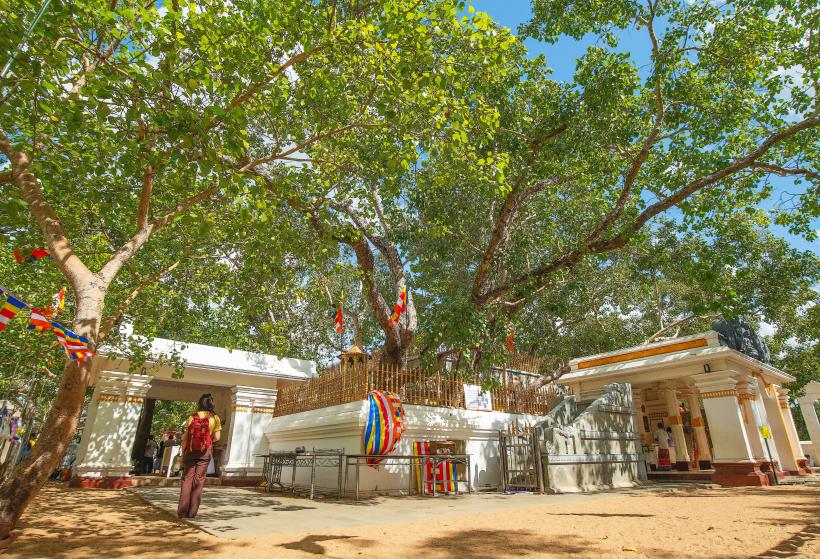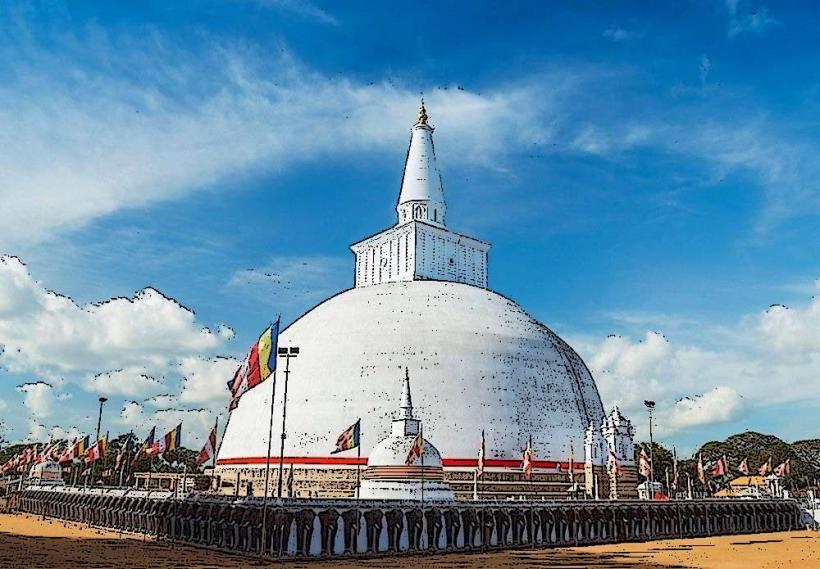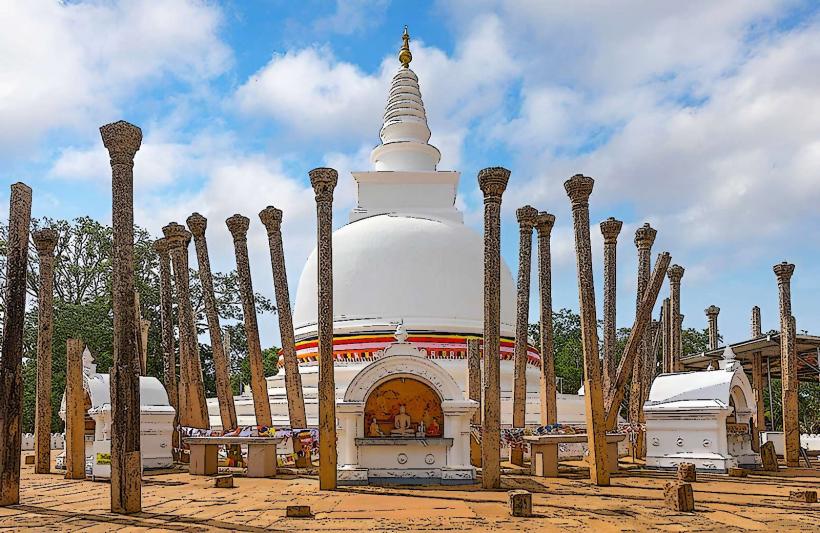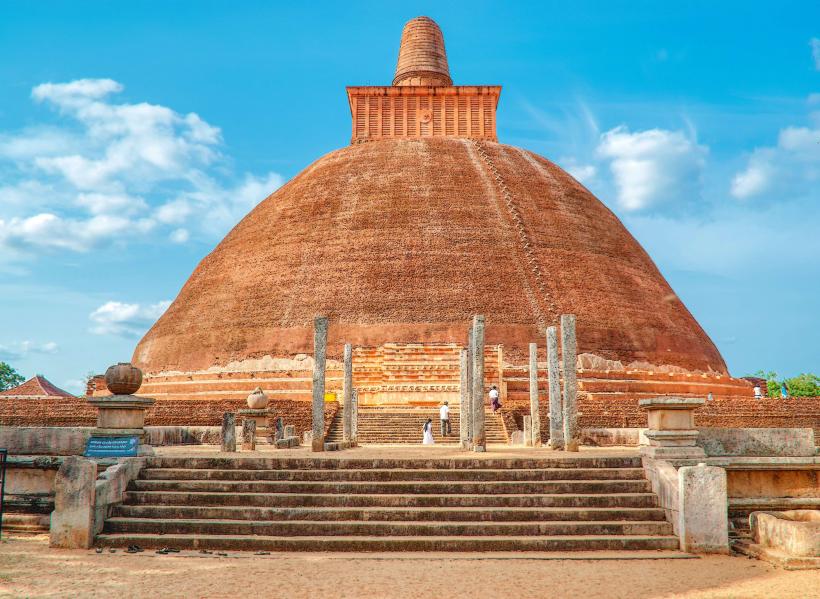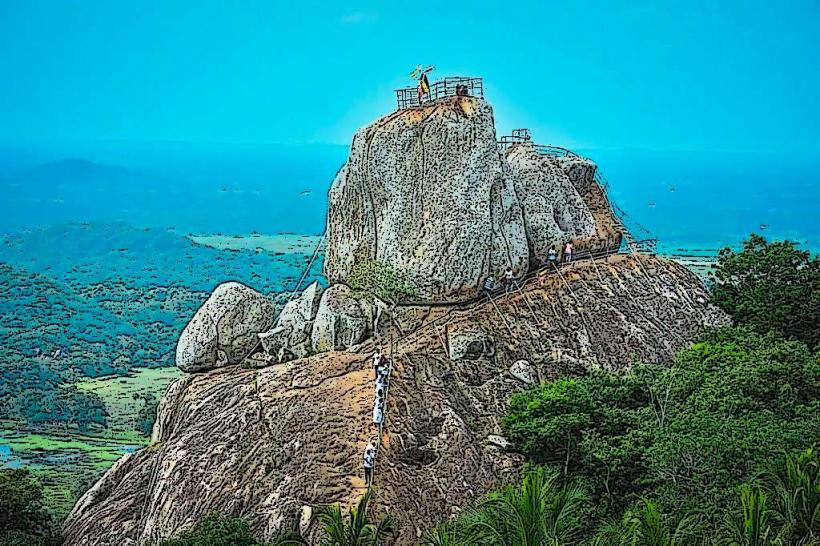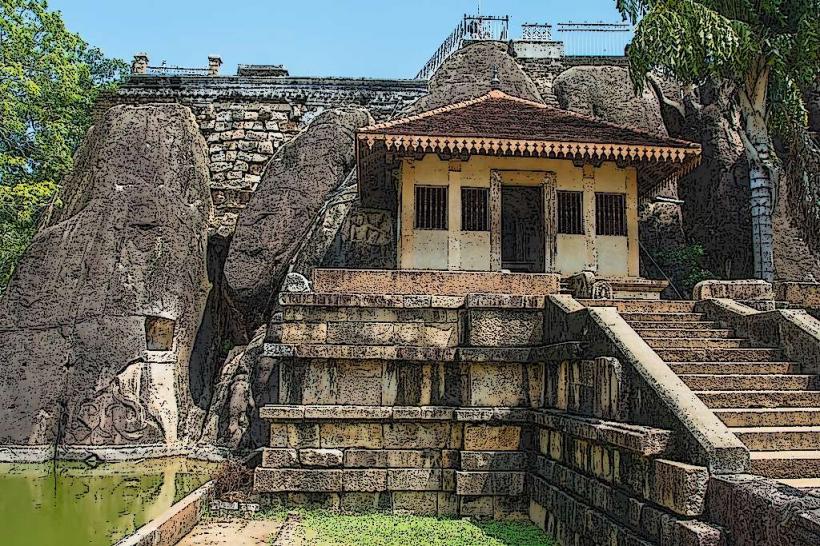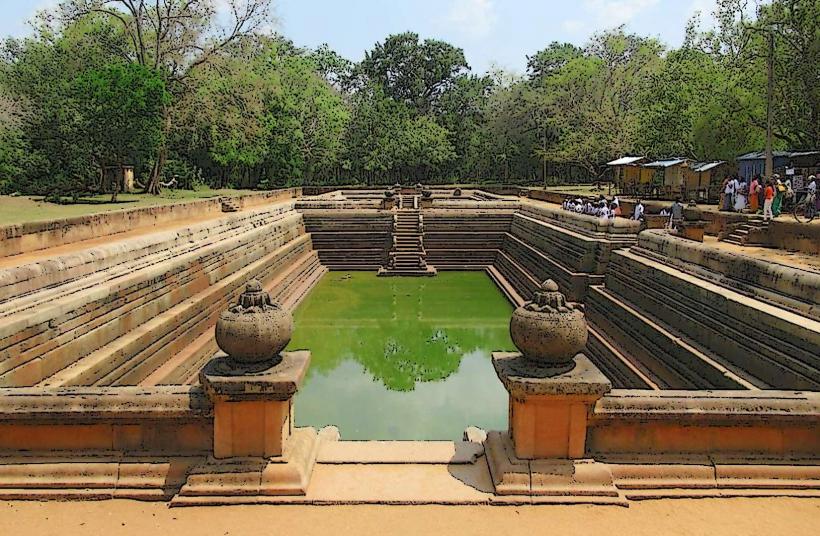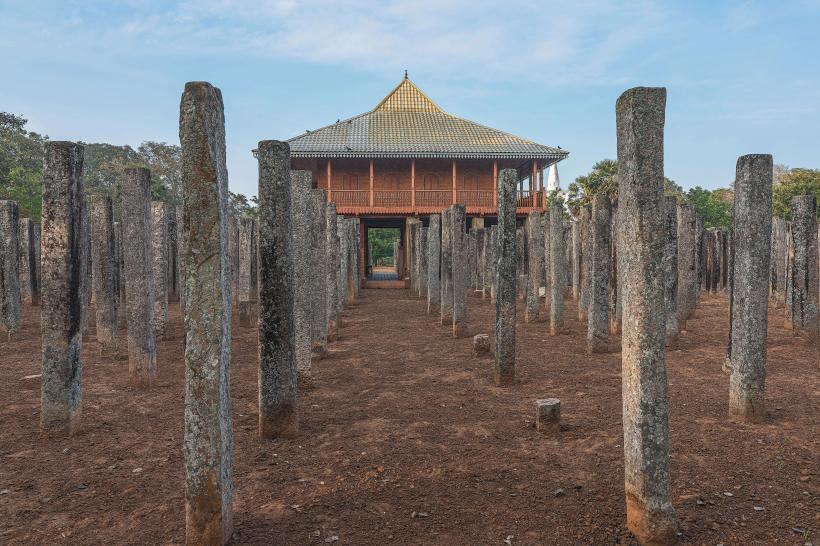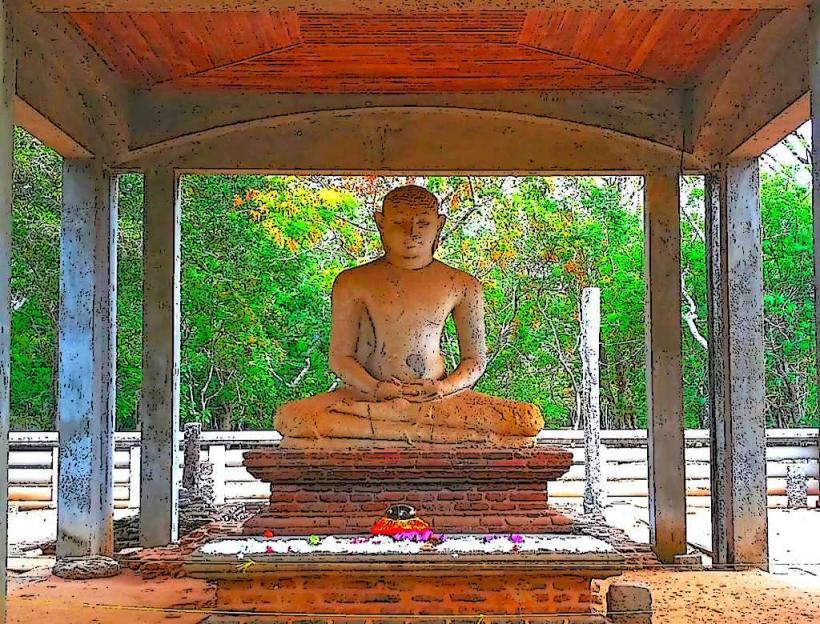Information
Landmark: Abhayagiri StupaCity: Anuradhapura
Country: Sri Lanka
Continent: Asia
Abhayagiri Stupa, Anuradhapura
The Abhayagiri Stupa is one of the most prominent and historically significant stupas in Sri Lanka, located in the ancient city of Anuradhapura. It stands as a testament to Sri Lanka’s rich Buddhist heritage and ancient architecture, and it continues to be an important religious site for Buddhists.
Overview
- Name: Abhayagiri Stupa
- Location: Anuradhapura, North Central Province, Sri Lanka
- Type: Buddhist Stupa
- Religious Significance: The stupa is a central site of veneration for Buddhists and was a major religious complex in ancient Sri Lanka.
- Period of Construction: 2nd century BCE
- Height: Approximately 75 meters (246 feet)
Historical and Religious Significance
Construction by King Vattagamani Abhaya:
- The Abhayagiri Stupa was built by King Vattagamani Abhaya (also known as King Walagamba) in the 2nd century BCE. King Vattagamani Abhaya constructed the stupa after reclaiming the throne and stabilizing the kingdom following a period of turmoil. The stupa was named "Abhayagiri," which means "Hill of Safety", symbolizing the protection and sanctity it provided to the people of Sri Lanka.
Role in Sri Lankan Buddhism:
- The Abhayagiri Stupa was not only a major religious site but also the center of the Abhayagiri Monastery, one of the most influential Buddhist monasteries in Sri Lanka. The monastery played a pivotal role in the development of Theravada Buddhism and was known for its progressive and scholarly approach to Buddhist teachings.
- The stupa housed relics of the Buddha and served as a major center for Buddhist study, meditation, and religious practices. It became an important pilgrimage site, attracting Buddhist monks, scholars, and lay devotees from all over the island.
Rivalry with the Mahavihara Monastery:
- The Abhayagiri Monastery and the Mahavihara Monastery (another significant Buddhist monastery in Anuradhapura) were often in competition, representing different sects of Buddhism. The rivalry contributed to the development of different schools of thought and practices in Sri Lankan Buddhism.
Incorporation of Buddhist Relics:
- The stupa is believed to have been constructed to enshrine sacred relics of the Buddha and served as a site where religious rituals, offerings, and ceremonies were conducted. Its significance as a relic shrine made it a revered and venerated site in Sri Lankan Buddhism.
Architectural Features
Massive Dome Structure:
- The Abhayagiri Stupa is one of the largest stupas in Sri Lanka, standing at approximately 75 meters (246 feet) in height. Its massive dome structure is one of the tallest and most impressive in the country. It is surrounded by a stone platform and pillars, marking the sacred area around the stupa.
Circular Design:
- The stupa follows the typical Buddhist stupa design, which features a circular base representing the universe, with the dome symbolizing the Buddha’s enlightenment. The stupa’s design is meant to represent the cycle of birth, death, and rebirth, with the golden spire on top symbolizing the Buddha’s nirvana.
Decorative Elements:
- The stupa is decorated with several intricate carvings and sculptures depicting Buddhist symbols such as the lotus, dharmachakra (wheel of Dharma), and other motifs related to Buddhist teachings. The base of the stupa is surrounded by a series of stone pillars, many of which are thought to have supported the ancient monastic structures that once surrounded the stupa.
Ancient Monastic Complex:
- In addition to the stupa, the Abhayagiri Monastery complex includes several other structures, including meditation halls, living quarters for monks, lecture halls, and smaller stupas. Archaeological evidence suggests that the monastery was a vibrant religious center with a well-organized layout designed to accommodate a large community of monks and pilgrims.
Cultural and Religious Importance
Place of Pilgrimage:
- The Abhayagiri Stupa is still an important pilgrimage site for Buddhists, and it is visited by thousands of devotees every year. Pilgrims come to the stupa to pay their respects to the Buddha and seek spiritual merit. The stupa is especially busy during Poya days (full moon days), when special religious ceremonies and offerings are held.
Role in the Preservation of Buddhist Teachings:
- The Abhayagiri Monastery was one of the largest centers for the study and preservation of Buddhist teachings. Many Buddhist scriptures and manuscripts were stored and studied here, and the monastery played a key role in the spread of Theravada Buddhism across Sri Lanka and beyond. It is believed that many Buddhist monks who studied at the Abhayagiri Monastery went on to spread Buddhism to other regions in Southeast Asia.
Cultural Heritage:
- The Abhayagiri Stupa and its surrounding monastery complex are not only important religious sites but also significant cultural landmarks. The stupa and the monastery reflect the art, architecture, and spiritual life of ancient Sri Lanka. The stupa’s decoration and the surrounding ruins are a rich source of archaeological and historical study.
Restoration and Preservation
- Restoration Efforts:
- Over the centuries, the Abhayagiri Stupa and monastery complex have undergone various phases of restoration and preservation. The stupa itself has been restored several times, especially after damage from invasions, natural disasters, and the passage of time. These restoration efforts have helped preserve the stupa as an important religious and historical monument.
- Ongoing Preservation:
- Today, the Abhayagiri Stupa is managed and preserved by the Sri Lankan government and Buddhist organizations. Ongoing efforts ensure that the stupa remains a place of worship and pilgrimage, as well as a site for archaeological study.
Visitor Experience
Access:
- The Abhayagiri Stupa is located within the Sacred City of Anuradhapura, making it easy to access as part of a larger tour of the ancient city. The stupa is situated in a tranquil environment, surrounded by lush greenery and other important Buddhist sites.
Religious Etiquette:
- As with other Buddhist sites, visitors to the Abhayagiri Stupa are encouraged to dress modestly, remove their shoes before entering the sacred area, and walk clockwise around the stupa as a mark of respect. Visitors are also advised to maintain a peaceful and reflective attitude while at the site.
Touring the Complex:
- Visitors can explore not only the stupa but also the surrounding ruins of the monastery. The stone pillars, ancient buildings, and archaeological artifacts offer a fascinating glimpse into the past and the rich history of Sri Lankan Buddhism.
Nearby Attractions
Ruwanwelisaya Stupa (Approx. 2 km):
- Another iconic stupa in Anuradhapura, the Ruwanwelisaya Stupa is one of the largest and most important stupas in Sri Lanka. It is believed to house sacred relics of the Buddha and serves as a major center of pilgrimage.
Sri Maha Bodhi Tree (Approx. 2 km):
- The Sri Maha Bodhi Tree is one of the oldest and most revered trees in Sri Lanka. It is believed to be a sapling from the original Bodhi Tree in India, under which the Buddha attained enlightenment.
Jetavanaramaya Stupa (Approx. 3 km):
- The Jetavanaramaya Stupa is one of the tallest and largest stupas in Sri Lanka, known for its impressive architecture and significance in the development of Sri Lankan Buddhism.
Conclusion
The Abhayagiri Stupa is an architectural masterpiece and an important religious site in Sri Lanka. Its historical significance, association with King Vattagamani Abhaya, and role in the development of Sri Lankan Buddhism make it one of the key landmarks in the Sacred City of Anuradhapura. The stupa continues to attract thousands of pilgrims and visitors each year who come to admire its grandeur, seek spiritual merit, and learn about Sri Lanka’s rich Buddhist history.

